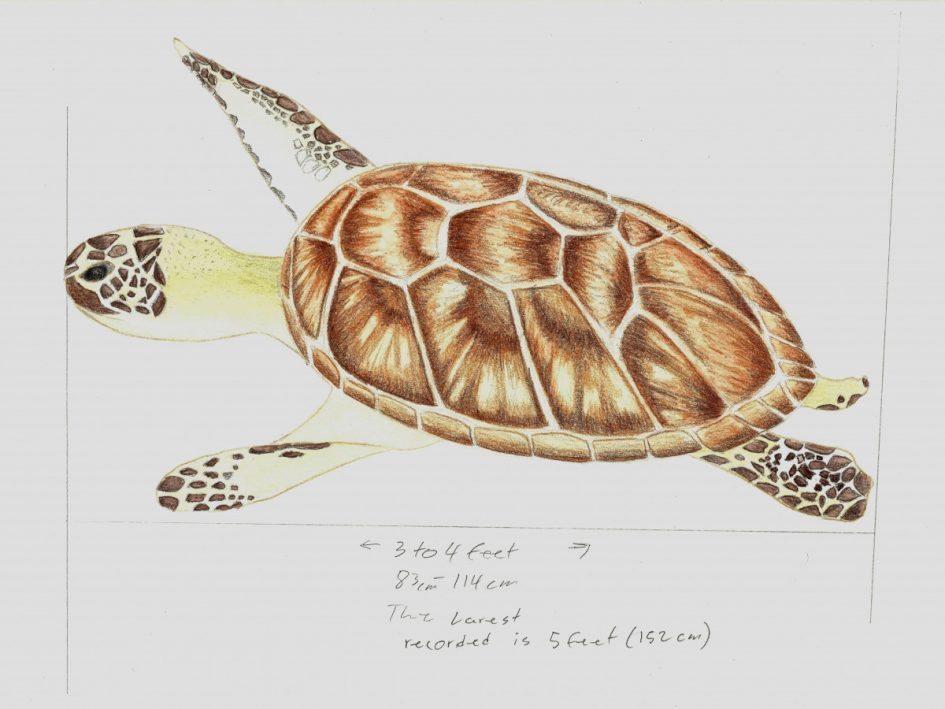By Hasani Patterson
The green sea turtle, also known as Chelonia mydas, named for the color of its under Belly/under shell, and in some places around the world, the Pacific green sea turtle is called the black sea turtle (Hamann, 2010). Minor differences in shape exist between Green sea turtles found in the Pacific vs. the Atlantic. Compared to their Atlantic counterparts Pacific green sea turtles (A.k.a. black sea turtles) have a vaulted shell meaning strongly elevated and appear less around when viewed from the front (Hamann, 2010). But the pigmentation is where the differences are more noticeable, with Pacific greens having a dark grey to the black carapace, and the hatchlings are a dark-brown or black with a narrow white border with white underneath(Hamann, 2010). In comparison, Atlantic greens color varies from pale to very dark green and plain to vibrant yellow, brown and green tones with radiating stripes. The plastron varies from white, dirty white, or yellowish. Both Pacific and Atlantic adults are 3 to 4 feet in carapace length (83 – 114 cm). The green turtle is the largest of the Cheloniidae family. Adults weigh between 240 and 420 pounds (110 – 190 kg). The largest green turtle ever found was 5 feet (152 cm) in length and 871 pounds (395 kg) wow, that’s big (Sea Turtle Conservancy, 2004).

Their habitat is generally seen as the coastlines and around islands, in protected shores and bays. It’s highly unusual and rare to observe Green sea turtles out in the open ocean (Sea Turtle Conservancy, 2004). They tend to like seagrass beds as their preferred environment. They Can be found in tropical and temperate waters around the world (Hamann, 2010). The diet of Green sea turtles changes throughout life as it develops. As a hatchling, they Practice Omnivorism, eating Grasses, algae, aquatic insects, worms, and young crustaceans. When they reach 8 to 10 inches (20 – 25cm) in length, their diets become more herbivore like in nature, with adults strictly presenting herbivore eating habits. The tearing of vegetation is quite easy when you’re sporting serrated Jaws like the green sea turtle. By feeding on seagrass beds, they maintain A perfect feeding ground for many other species
As aquatic reptiles, Green sea turtles must lay eggs to reproduce. This nesting process happens on average every two years for each female with wide year to year fluctuations in the number of females nesting. This process must occur on land. One of the most prominent nesting spots in the world is on the beaches of Florida in the United States. In a Cingular season of nesting, a female will nest 3 to 5 times with about an average of 115 eggs per nest. With an incubation period of about 60 days. Once hatched, these little hatchlings must dig their way out of the sand and crawl to the ocean. Depending on the time of day when they hatch, this process can be more difficult for several reasons. If it is during the day, hatchlings are more likely to encounter predators in their mad dash to the ocean, such as birds, dogs, crabs, and raccoons, to name a few. They are helping to maintain that food web between land and Sea. While the night is not free from predators, a more substantial threat looms nearby. Modern humanity in our need for limitation has inadvertently created a trap for hatchling Sea turtles of all species(Ehrenfeld, 1967). Young Hatchlings use the moon as a beacon to the ocean, but the effects of light pollution near public beaches causes them to wander inland, ultimately resulting in death (Sea Turtle Conservancy, 2004). The source of this pollution is street lights, hotels, and resorts with a beachside presence.

All sea turtles can see Well under the water and are short-sighted in the air. While showing no sensitivity to red and orange light like their freshwater counterparts, it’s generally accepted that they can perceive near-ultraviolet light, Violet, blue, and yellow light(Ehrenfeld, 1967). When it comes to orientation, it is believed that sea turtles generally rely on eyesight and no extrasensory import like birds in their ability to sense a magnetic direction (Ehrenfeld, 1967).
Works cited
Ehrenfeld, David W., and Archie Carr. “The Role of Vision in the Sea-Finding Orientation of the Green Turtle (Chelonia Mydas).” Animal Behaviour, vol. 15, no. 1, 1967, pp. 25–36., doi:10.1016/s0003-3472(67)80007-1. Helped me determine the role of vision in orientation of young hatchlings To the sea. Fascinating information about sea turtle eyes as well
Hamann, M, et al. “Global Research Priorities for Sea Turtles: Informing Management and Conservation in the 21st Century.” Endangered Species Research, vol. 11, no. 3, 2010, pp. 245–269., doi:10.3354/esr00279. This has a ton of different questions from dozens of researchers about sea turtle behavior and biology. This was my jumping off point
“Information About Sea Turtles: Green Sea Turtle.” Sea Turtle Conservancy, 2004, conserveturtles.org/information-sea-turtles-green-sea-turtle/. General information about sea turtles and conservation efforts

